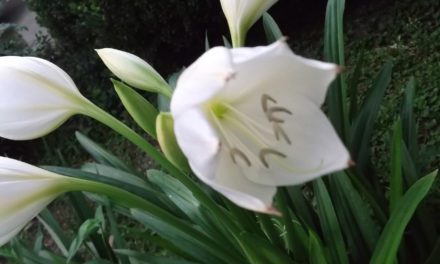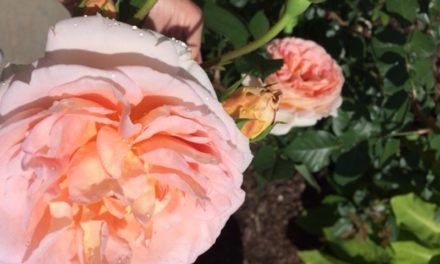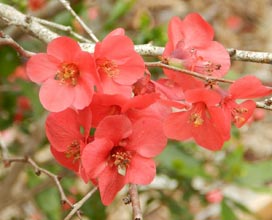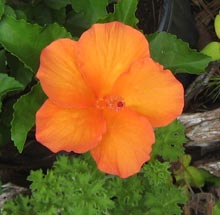 While leaves may have similarities in shape, size, color, or texture, there is an awful lot of variation too. Leaf shape and size are invaluable in determining the identity of a plant. Botanists look at the way leaves are arranged on the stem as well. “Node” is a botanical term for the location of buds on a stem. Buds can become leaves, branches, or flowers. If two buds appear oppositely at a node the plant is “oppositely arranged.” If only one bud appears, that is called alternate arrangement. For example most hollies are alternately arranged; boxwood, maple, and dogwood are oppositely arranged. The other types of leaf arrangement include whorled, basal, radicle, and equitant. Three or more leaves are inserted in the node, leaves occur mainly at the base of the stem, all of the leaves appear near the root, and leaves are folded or flattened so that the two edges are turned toward and away from the stem (think yucca), respectively.
While leaves may have similarities in shape, size, color, or texture, there is an awful lot of variation too. Leaf shape and size are invaluable in determining the identity of a plant. Botanists look at the way leaves are arranged on the stem as well. “Node” is a botanical term for the location of buds on a stem. Buds can become leaves, branches, or flowers. If two buds appear oppositely at a node the plant is “oppositely arranged.” If only one bud appears, that is called alternate arrangement. For example most hollies are alternately arranged; boxwood, maple, and dogwood are oppositely arranged. The other types of leaf arrangement include whorled, basal, radicle, and equitant. Three or more leaves are inserted in the node, leaves occur mainly at the base of the stem, all of the leaves appear near the root, and leaves are folded or flattened so that the two edges are turned toward and away from the stem (think yucca), respectively.
Leaf shapes can really vary and give lots of clues about a plant’s identity. Some common shapes are round, linear, triangular, heart shaped, or oval. The leaf can also have lobes, teeth, or wavy margins. A simple leaf has one stem called a petiole, which attaches the blade to the branch. Hickories and ash have compound leaves. I have lots of hickories on the bank by my screen porch. One day as I was looking up at a tree that I had assumed was another hickory, I noticed it did not have compound leaves; they were heart shaped and toothed. I sprang out of the hammock and grabbed a trusty field guide and . . . lo and behold . . . it was a basswood tree that had been hosting yellow-bellied sapsucker families for generations. Ferns and some Japanese maples have finely dissected leaflets or leaves. Sword ferns and ebony spleenwort have fronds that are pinnate, resembling a feather.
Size of leaves relates in design to texture and weight of landscape material. Large leaves translate into coarse texture and can give very dramatic appeal to a landscape. Small and medium textures are used in masses for shrub borders, clipped hedges and focal specimens. There are a couple of outstanding examples of large leaved perennials and shrubs used in shade and sunny locations. Oak leaf hydrangeas, split-leaf Philodendron, Acanthus, Farfugium, and Fatsia will add fabulous texture and interest to a garden bed or border. Some small leaved favorites of mine are Serissa, ‘chocolate chip’ Ajuga, maidenhair fern, and partridge berry.
The veins in a leaf are comparable to our circulatory system. Our veins carry deoxygenated blood back to the heart where it is resupplied with oxygen and recirculated to the body, especially places of rapid cell growth and division. The vascular system in plants carries water and dissolved nutrients from the soil through tiny root hairs to vessels called xylem. Water is lifted by several super cool physics principles to the leaves. There, in the presence of sunlight, the chlorophyll molecules transform Carbon dioxide and water into a simple sugar. Liquid sugar, fats, oils and protein are then carried throughout the entire plant to replenish senescent cells and to areas of rapid growth and cell division. Photosynthesis is not only cool, but it is cooling the landscape by evaporative transpiration. The byproduct is the Oxygen that humans and all other animals need to survive. Veins in the leaves are helpful in identification and may be linear and parallel, netted, palmate, or pinnate.
Leaf color and fragrance are equally fascinating, decorative, and descriptive of different types of plants. While some leaves are just green, there are many shades of green. Hues and variegation of leaves also help improve the landscape palette, and new colors are going to be the “dah-lings” of garden writers and plant enthusiasts. Plants also employ certain colors as sunscreen. Odd coloration could be an indication of disease, or environmental problem if we see premature fall color or leaf drop.
More plants are probably bought for the color of leaves and flowers than for anything else. Fragrance and food are equally important to the quality of our lives. Foliage that can be crushed and gives a pleasant odor or taste: of pine, lavender, rosemary, lemon, and sweet bay . . . priceless! Please don’t forget the Oxygen.
JEFFY, LAURA LEE REQUESTED THAT WE PLEASE ATTACH THE FOLLOWING AT THE END OF HER COLUMNS:
Clemson University Cooperative Extension Service offers its programs to people of all ages, regardless of race, color, gender, religion, national origin, disability, political beliefs, sexual orientation, marital or family status and is an equal opportunity employer








